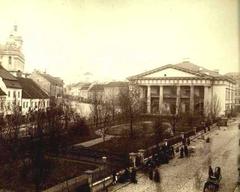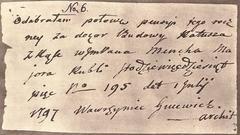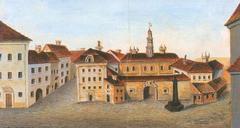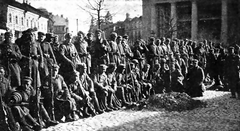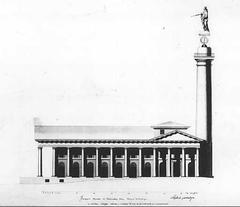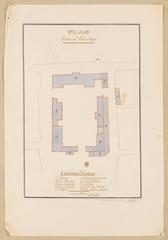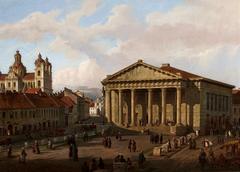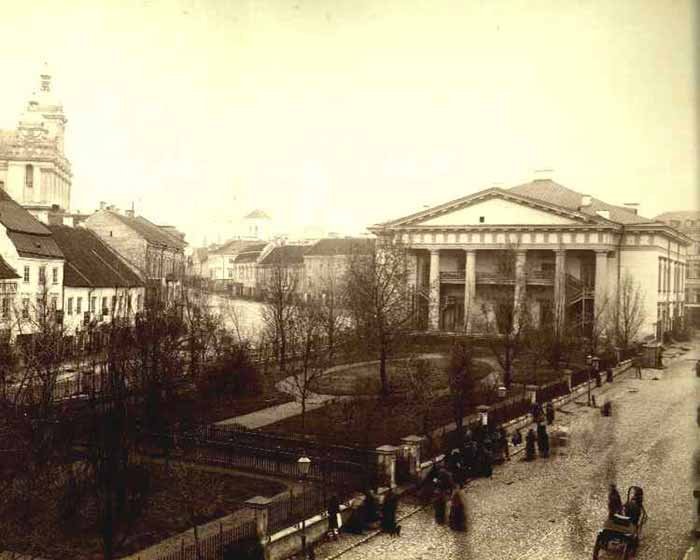
Town Hall Vilnius: Visiting Hours, Tickets, and Historical Sites Guide
Date: 14/06/2025
Introduction
Vilnius Town Hall (Vilniaus rotušė) stands as one of Lithuania’s most iconic and enduring landmarks, blending centuries of civic history, architectural grandeur, and vibrant cultural life. Located at the heart of Vilnius Old Town, it serves as both a testament to the city’s medieval origins and a dynamic center for modern-day events and gatherings. Whether you are a history enthusiast, an architecture aficionado, or a cultural traveler, Vilnius Town Hall offers a rich experience that bridges Lithuania’s storied past with its contemporary vibrancy.
This comprehensive guide provides detailed information on the historical and architectural significance of Vilnius Town Hall, practical visitor information including hours and ticketing, accessibility details, and tips for exploring nearby attractions. For the latest updates and in-depth resources, refer to official tourism sites and local guides (Evendo, True Lithuania, Vilniaus rotušė history).
Table of Contents
- Medieval Origins and Early Development
- Architectural Evolution: From Gothic to Neoclassical
- Political and Social Significance
- Visiting Vilnius Town Hall: Hours, Tickets, and Accessibility
- Nearby Attractions and Travel Tips
- Restoration and Modern-Day Role
- Cultural Heritage and Symbolism
- FAQ
- Practical Tips for Visitors
- Conclusion and Call to Action
- References
Medieval Origins and Early Development
Vilnius Town Hall’s history dates back to 1432, during the reign of Grand Duke Sigismund Kęstutaitis. The original structure, built in the Gothic style, reflected the city’s emergence as a major political and economic center within the Grand Duchy of Lithuania. As the administrative heart of Vilnius, the Town Hall hosted the city’s magistrate, judicial proceedings, and key civic gatherings, taking advantage of its strategic location at the intersection of major trade routes (Evendo).
Architectural Evolution: From Gothic to Neoclassical
The Town Hall underwent several reconstructions, mirroring both architectural trends and the city’s fortunes. The most significant transformation occurred between 1785 and 1799, when renowned Lithuanian architect Laurynas Gucevičius reimagined the building in the neoclassical style. Gucevičius’s design introduced a harmonious, symmetrical façade with six Ionic columns and a triangular pediment, embodying Enlightenment ideals of order and civic virtue (Vilniaus rotušė history). Inside, spacious halls and grand staircases provided settings for municipal functions, social events, and ceremonies.
Beneath the Town Hall, preserved 15th-century Gothic cellars now serve as atmospheric spaces for exhibitions and guided tours, offering a unique glimpse into the building’s medieval origins (Spotting History).
Political and Social Significance
Throughout its history, Vilnius Town Hall has been central to civic life. During the Polish-Lithuanian Commonwealth era, it served as the seat of the city council and hosted key political assemblies. Notably, it was the venue for the Great Seimas of Vilnius in 1905, which played a pivotal role in the movement toward Lithuanian independence (True Lithuania). Following periods of neglect during foreign occupations, the Town Hall was revitalized after Lithuania regained independence, resuming its role as a symbol of municipal authority and cultural identity.
Visiting Vilnius Town Hall: Hours, Tickets, and Accessibility
- Visiting Hours: Generally open Tuesday–Sunday, 10:00 AM–6:00 PM. Closed Mondays and public holidays. Hours may vary during special events (Evendo).
- Tickets: Entrance to the main halls is typically free. Some exhibitions, guided tours (including the Gothic cellars), or special events may require tickets, usually priced between €3 and €7. Tickets can be purchased on-site or via the official Vilnius tourism website.
- Accessibility: The Town Hall is wheelchair accessible, with ramps and elevators. The Gothic cellars have limited accessibility due to uneven floors.
- Guided Tours: Available in multiple languages, including English and Lithuanian. Advance booking is recommended, especially for cellar tours.
Nearby Attractions and Travel Tips
Situated on Didžioji Street in the heart of Vilnius Old Town, the Town Hall is surrounded by major attractions:
- Vilnius Cathedral – The city’s main religious landmark.
- Pilies Street – A historic thoroughfare filled with shops, cafés, and local culture.
- Gediminas Tower – Offering panoramic views of the city.
- Presidential Palace and Bernardine Gardens – Both within walking distance.
Travel Tips:
- Visit during spring or autumn for mild weather and fewer crowds (Wildside Travellers).
- Attend major events like the Kaziukas Fair (March), Street Music Day (May), or the Christmas Market (December) for a lively atmosphere (GoVilnius).
- Use public transport or walk from nearby attractions; the area is highly pedestrian-friendly.
Restoration and Modern-Day Role
Extensive restoration between 1997 and 2001 preserved the Town Hall’s architectural integrity and revitalized its role in city life (True Lithuania). Today, it functions as:
- A ceremonial municipal building.
- A venue for art exhibitions, concerts, and cultural events.
- A popular choice for weddings, receptions, and international conferences (Evendo).
The adjacent Town Hall Square (Rotušės aikštė) remains a bustling hub, hosting markets, festivals, and public gatherings throughout the year.
Cultural Heritage and Symbolism
Vilnius Town Hall is an enduring symbol of the city’s resilience, democratic values, and cultural diversity. Its neoclassical façade, iconic columns, and clock tower are frequently featured in art and photography, underscoring its status as a civic emblem (Evendo). The building’s continued use for public celebrations, intercultural events, and municipal ceremonies highlights its ongoing relevance in Vilnius’s urban narrative.
Frequently Asked Questions (FAQ)
Q: What are the current visiting hours?
A: Typically, Tuesday to Sunday, 10:00 AM to 6:00 PM. Closed Mondays and public holidays.
Q: Do I need a ticket to enter?
A: Entry to the main halls is generally free. Special exhibitions or guided tours may require a ticket.
Q: Is the Town Hall wheelchair accessible?
A: Yes, with ramps and elevators. Note that access to the Gothic cellars is limited.
Q: How do I get there?
A: Located at Didžioji g. 31, Vilnius Old Town. Easily accessible on foot, by public transport, or bicycle.
Q: Are guided tours available in English?
A: Yes, tours are offered in English and Lithuanian. Advance booking is recommended.
Practical Tips for Visitors
- Check event calendars for festivals and exhibitions (Vilnius Events).
- Photography: Best captured during golden hour or festive seasons.
- Dining: Explore nearby cafés and the Paupys Market for local cuisine (Wildside Travellers).
- Virtual Tours: Interactive maps and virtual tours are available on official tourism sites (GPSmyCity).
Conclusion and Call to Action
Vilnius Town Hall is much more than a historical building—it is a vibrant center of civic life, cultural celebration, and architectural beauty. Its grand halls, atmospheric cellars, and lively square offer a rich and varied experience for every visitor. As Vilnius continues its journey as a modern European capital and 2025 European Green Capital, the Town Hall remains a bridge between the city’s illustrious past and its dynamic present.
For up-to-date visiting hours, ticketing information, and event details, consult official resources. Enhance your visit with audio guides and local insights by downloading the Audiala app, and follow our channels for the latest on festivals and exhibitions. Your journey into the heart of Vilnius’s heritage starts at the Town Hall.
References
- Evendo: Vilnius Town Hall
- True Lithuania: History of Vilnius
- Vilniaus rotušė history
- GoVilnius: City Events and Highlights
- Spotting History: Vilnius Town Hall
- Live the World: Vilnius Town Hall
- GPSmyCity: Town Hall and Town Hall Square
- Wildside Travellers: Vilnius Tips
- Vilnius Events
- Trek Zone: City Hall Vilnius
- Destination Abroad: Is Vilnius Worth Visiting?
